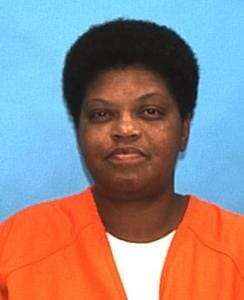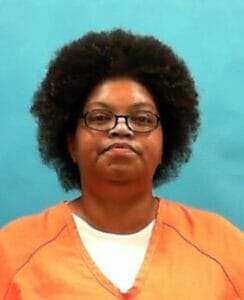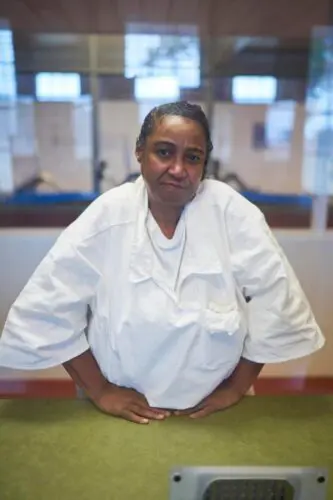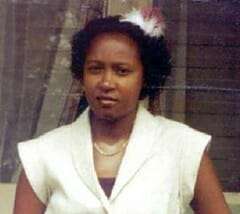
Tina Brown is currently on Florida death row for the murder of a young woman. According to court documents Tina Lasonya Brown and the victim were involved in an argument that quickly turned deadly. The victim was hit with a stun gun and a crowbar before being kidnapped and brought to a wooded area where she was then set on fire. The victim would die two weeks later in hospital. Tina Lasonya Brown would be arrested, convicted and sentenced to death
Tina Lasonya Brown 2021 Information

| DC Number: | 155917 |
|---|---|
| Name: | BROWN, TINA L |
| Race: | BLACK |
| Sex: | FEMALE |
| Birth Date: | 07/19/1970 |
| Initial Receipt Date: | 10/03/2012 |
| Current Facility: | LOWELL ANNEX |
| Current Custody: | MAXIMUM |
| Current Release Date: | DEATH SENTENCE |
Tina Lasonya Brown Other News
A Pensacola woman on death row for the fatal assault, kidnapping and burning of her neighbor had her most recent appeal denied last week.
Tina Lasonya Brown, 48, was one of three people who in 2010 ambushed 19-year-old Audreanna Zimmerman, attacked her repeatedly with a stun gun, gagged her, stuffed her in the trunk of a car, drove her into the woods, beat her with a crowbar, doused her with gasoline, set her on fire and left her to die.
In 2017, Tina Lasonya Brown filed a motion for post-conviction relief that raised numerous arguments for vacating her conviction and sentence. Among them were claims that her attorneys were ineffective, that multiple jurors should have been dismissed from the trial because of their biases and that “new evidence” implicated one of her co-defendants was more culpable in the murder than jurors were led to believe.
In a 110-page order filed Friday, Circuit Judge Gary L. Bergosh reviewed all of Tina Lasonya Brown’s arguments and found them insufficient. In most instances, the accusations failed to provide supporting evidence or demonstrate how they had impacted the outcome of the trial.
Tina Lasonya Brown was the only one of the three co-defendants who received the death penalty in the case. Tina Lasonya Brown’s daughter Britnee Miller, who was 16 when she participated in the vicious attack, was sentenced to life in prison for her role in the murder.
Heather Lee, a friend and neighbor of Tina Lasonya Brown and Miller, was the third accomplice in the killing, and she was sentenced to 25 years in prison after making a plea agreement with the state.
Much of Tina Lasonya Brown’s appeal was dedicated to a claim that Lee had actually been the party most responsible for Zimmerman’s killing.
The appeal claimed Lee wanted revenge against Zimmerman because she had an affair with Lee’s husband. It said all the weapons used in the attack — the stun gun, crowbar and gas can — came from Lee’s house, and that Lee later admitted to associates she had been the one to set Zimmerman on fire.
Tina Lasonya Brown’s appeal said multiple witnesses could have testified to these facts, but Bergosh noted that none of that testimony would have affected the case against Brown. He said there was evidence Brown had been the one to use the stun gun against Zimmerman, to kidnap her and to beat her with the crowbar.
“The evidence is simply too strong against (Tina Lasonya Brown) that she played a substantial role in the victim’s murder,” the judge wrote. “… Regardless of whether (Brown) actually poured the gasoline and lit the victim on fire, the evidence at trial shows (Brown) was not being dominated or under extreme duress when she launched the fatal attack against the victim.”
Tina Lasonya Brown was sentenced to death because of the brutality of Zimmerman’s murder, and she is currently one of only three Florida women on death row.
Tina Brown More News
In March 2010, Tina Brown, Brown’s sixteen-year-old daughter Britnee Miller, Heather Lee, and Audreanna Zimmerman lived in neighboring trailers in an Escambia County mobile home park. The four women were initially good friends, but their relationships—particularly between Miller, Brown, and Zimmerman— were volatile and often escalated to violence. Brown had previously accused Zimmerman of slashing her tires. Zimmerman had accused Brown of shattering a window in her car, having her boyfriend arrested, and reporting to the Florida Department of Children and Families that she was providing inadequate care to her children. Lee testified that she had intervened on multiple occasions to stop physical altercations between Miller and Zimmerman. On one occasion, Miller, who had recently discovered that Zimmerman was sexually involved with her boyfriend, attempted to strike Zimmerman. Zimmerman, however, defended herself by attempting to disable Miller with a stun gun. Later that day, Lee informed Brown that Zimmerman had used a stun gun on Brown’s daughter, to which Brown responded that she was “going to get” Zimmerman. 1 Several days later, on March 24, 2010, Brown invited Zimmerman to her home under the guise of rekindling their friendship. Before Zimmerman arrived, Brown, Miller, Lee, and Miller’s thirteen-year-old friend, were inside the trailer. Brown and Lee were in the kitchen, where Lee instructed Brown on the proper use of a stun gun. Miller then pulled her friend aside and told her, “we’re fixing to kill Audreanna [Zimmerman].” Shortly after 9 p.m., Zimmerman entered the trailer. 1. Lee’s testimony regarding Brown’s state of mind following the altercation was corroborated during trial by Corey Doyle, an inmate housed with Brown at the Escambia County jail. Doyle testified that Brown told her when she heard Zimmerman had used a stun gun on Miller, Brown informed Miller, “don’t worry, I’ll take care of it.” -2- Brown waited several minutes and then used the stun gun on Zimmerman multiple times. When Zimmerman lost muscular control and fell to the floor, Brown continued to use the stun gun on Zimmerman, who was screaming and crying for help. Eventually, Brown pulled Zimmerman across the trailer into the bathroom. Zimmerman continued to scream and cry for help, so Miller struck Zimmerman in the face and Lee stuffed a sock into Zimmerman’s mouth. Zimmerman was then forcibly escorted outside and forced into the trunk of Brown’s vehicle.2 Brown, Miller, and Lee then entered the vehicle and drove away. The women drove to a clearing in the woods about a mile and a half from the trailer park. Brown exited the car and pulled Zimmerman out of the trunk. Zimmerman attempted to flee, but stumbled in the darkness and was caught by Brown and Miller. The two women wrestled Zimmerman to the ground and simultaneously attacked her. Brown used the stun gun again on Zimmerman as Miller beat her with a crowbar. Brown and Miller then switched weapons and continued to torture and beat Zimmerman. Miller eventually dropped the stun gun and repeatedly punched Zimmerman. Brown returned to the car, retrieved a can of gasoline from the trunk, and walked back toward the beaten and prone, but still 2. During trial, Lee disputed this summation of what occurred in the trailer after Brown began to attack Zimmerman. The veracity of Lee’s testimony concerning her involvement in this crime, however, was significantly challenged during trial, particularly because Lee, who claimed that she was a victim and was not involved in Zimmerman’s murder, pled guilty to second-degree murder based on her involvement in Zimmerman’s death. -3- conscious, Zimmerman. Brown poured gasoline on Zimmerman, retrieved a lighter from her pocket, set Zimmerman on fire, and stood nearby to watch the screaming Zimmerman burn. Lee testified that she was standing beside Miller, who exuberantly jumped up and down and screamed, “Burn, bitch! Burn!” After a few minutes, the three women returned to the car and drove away. During the ride home, Miller said, “Mom, you’ve got to turn around. I left my shoes and the taser.” Brown, however, refused to return to the location of the event. Shortly thereafter, Terrance Hendrick was outside his home which was located approximately one third of a mile away from the location of the attack. Hendrick heard a faint female voice asking for help, but he could not see anyone in the darkness. Eventually, Hendrick saw Zimmerman walking slowly toward his house. When Zimmerman reached Hendrick’s house, she asked for assistance and sat on the front steps. As he waited on the porch with Zimmerman, Hendrick noticed that she had suffered a significant head injury, did not appear to be wearing clothes, and had a strong odor of gasoline. He testified that her skin was black and he could not identify her race. At 9:24 p.m., an emergency medical technician (EMT) arrived at the scene. When the EMT approached Zimmerman, he observed her sitting on the porch, rocking back and forth with her arms straight out. Due to the extensive nature of Zimmerman’s burns, the EMT testified that he could not initially identify whether -4- she was wearing clothing. The EMT noticed that Zimmerman’s skin was falling off her body, and he believed that over ninety percent of her body was burned. She had severe head trauma, and her jaw was either broken or severely dislocated. The EMT explained that the extent and severity of the burns prevented him from providing Zimmerman medical assistance. He testified that while he generally placed sterile gauze and oxygen on burns, he did not have enough gauze to cover her entire body. He attempted to stabilize her neck, but her skin was charred to such an extent that he could not touch Zimmerman without her skin rubbing off onto his gloves. Despite her injuries, Zimmerman was conscious and alert. She identified Brown and Lee as her attackers and told the EMT that she was “drug out of the house, tased, beaten in the head with a crowbar, and then set on fire.” She also provided her address as well as the addresses of her attackers, and asked the EMT to protect her children. The ambulance arrived within a few minutes and transported Zimmerman to the hospital. Inside the ambulance, Zimmerman repeatedly asked if she was going to recover. She told the paramedic that Brown, Miller, and Lee poured gasoline on her and set her on fire. She also stated that she “thought they had made up.” Zimmerman was stabilized at a local hospital and then transferred to the Burn Center at the University of South Alabama Hospital in Mobile, Alabama, where she died sixteen days later. -5- When Brown, Miller, and Lee returned to Brown’s trailer, Brown and Miller removed their bloodstained clothing and placed it in a garbage bag. Lee removed her shoes, which were also stained with blood, and placed them in the bag. Miller informed her friend, who had remained at the trailer during the attack, that she had injured her hand striking Zimmerman, and that the three women had set Zimmerman on fire. Miller and her friend then used Brown’s car to drive to the hospital to get medical care for Miller. Before returning from the hospital early the next morning, Miller discarded the bag of bloodstained clothing in a dumpster and attempted to remove the bloodstains from the inside of Brown’s car. With the information provided by Zimmerman, law enforcement officers apprehended Brown and Lee shortly after the attack and Miller was arrested after she returned from the hospital the next day. The three women were, however, released while Zimmerman was in the hospital. During that time, Brown informed her friend Pamela Valley that she, Miller, and Lee had beaten Zimmerman, forced her into a car, driven her to an open field and “lit her on fire and didn’t look back.” A few days later, Brown informed Valley that Zimmerman was still alive and requested Valley to finish her off. Valley declined and later reported the conversation to law enforcement. Brown, Miller, and Lee were re-arrested on April 9, 2010, the date of Zimmerman’s death. -6- At the scene of the burning, law enforcement officers discovered several pieces of evidence including a pair of white shoes; a stun gun with blood on the handle; paper stained with blood; an orange, gold, and black hairweave 3; a crowbar; and a pool of blood. Additional blood was discovered on the passenger seat headrest in Brown’s vehicle. During trial, a DNA expert testified that the blood on the headrest matched the known DNA profile of Zimmerman. Another DNA expert testified that the blood on the stun gun matched the known DNA profile of Brown. Finally, the medical examiner testified that the cause of Zimmerman’s death was multiple thermal injuries, and the manner of death was homicide. On June 21, 2012, a jury convicted Brown of the first-degree murder of Audreanna Zimmerman. During the penalty phase, the defense presented the testimony of several family members, including Brown’s two sons, her brother, her aunt, and two of her uncles. The defense also presented the testimony of Dr. Elaine Bailey, a psychologist, and introduced several family photos. The State presented one witness, Dr. John Bingham, a licensed mental health counselor, and also entered a photograph of Zimmerman into evidence.
https://www.courtlistener.com/opinion/2689191/tina-lasonya-brown-v-state-of-florida/
Frequently Asked Questions
Tina Lasonya Brown Photos


Tina Brown FAQ
Tina Brown 2021
Tina Brown is currently incarcerated at Lowell Annex the home of Florida Death Row for Women
Why Is Tina Brown on Death Row
Tina Brown was convicted of the kidnapping and murder of a woman



















